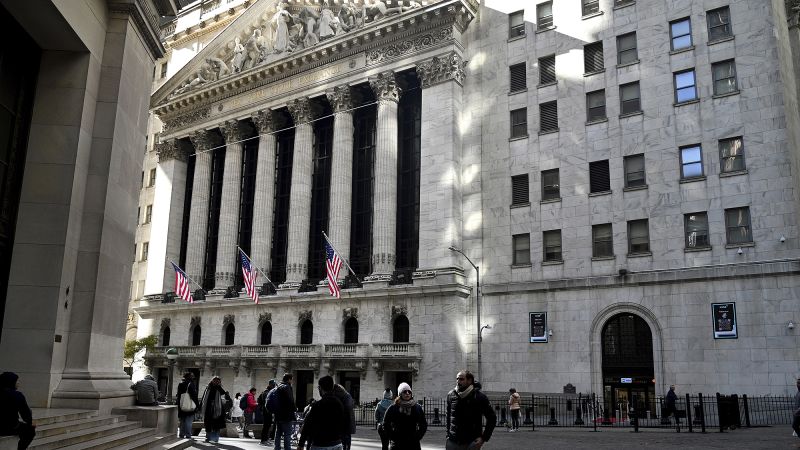A version of this story first appeared in CNN Business’ Before the Bell newsletter. Not a subscriber? You can sign up right here. You can listen to an audio version of the newsletter by clicking the same link.
The US presidential election is less than a year away. If history is any indication, stocks could end 2023 higher and extend those gains next year.
The S&P 500 index has climbed 14% in 2023, as Wall Street’s infatuation with artificial intelligence and optimism that the Federal Reserve could soon stop hiking interest rates have helped power stocks higher.
Wall Street has a laundry list of uncertainties that it worries could threaten the current stock rally, including the upcoming presidential election. But history shows that stocks typically gain during the fourth year of presidential terms.
Nothing is certain: Ongoing geopolitical strife in the Middle East, Russia and Ukraine could inject fear into the market and bump up prices for commodities like oil. Some economists warn that the lagged effects of the Fed’s interest rate hikes have yet to take full effect on the labor market and consumers’ pocketbooks.
There’s also the possibility of a recession, as the central bank’s benchmark lending rate hovers at its highest level in 22 years.
Of course, many economists and investors have pared back or axed their recession expectations in recent months, as the labor market and broader economy have proved largely resistant to the Fed’s punishing pace of rate hikes, and markets seem to believe the central bank is done raising rates this year.
The New York Fed, which gauges the risk of recessions by tracking the spread of 3-month and 10-year Treasury yields, estimates that there’s a 56% probability that the US economy will tip into a recession by September 2024.
The period right after Election Day tends to be positive for stocks: Darrell Crate, managing principal at Easterly Asset Management, said an election tends to help cut through ambiguity on Wall Street. Investors hate little more than uncertainty.
“The election is a process that creates clarity on the investing environment for the next two to four years,” said Crate. “There are fiscal policies that need to be refined, there are regulatory issues where the die will be cast.”
The S&P 500 index has added 5% in the eight weeks following Election Day through the end of the year in the median election year since 1984, compared to a 2.6% gain during the same period during non-election years, according to Goldman Sachs.
Still, stocks could see a milder rally next year. The S&P 500 has gained 6.2% on average during the fourth year of presidential terms since 1932, according to Yardeni Research. That’s below the 13.5% gain the index has averaged during the third year of presidential terms since 1931.
That makes sense when considering candidates’ priorities before voters start lining up at the polls, says Joe Abbott, chief quantitative strategist at Yardeni Research.
“Presidents and political parties want to have a strong economy and stock market in their favor before they hit the campaign trail in the fourth year,” wrote Abbott in an email to CNN.
During the first and second years of presidential terms, the S&P 500 has risen 6.7% and 3.3% on average, respectively, according to the same dataset.
Cleveland Fed President Loretta Mester to step down next year
Federal Reserve Bank of Cleveland President Loretta Mester is set to retire from her post next year, the bank announced Wednesday.
Mester, one of the US central bank’s most “hawkish” voices, is finishing her term on June 30, 2024, report my colleagues Bryan Mena and Elisabeth Buchwald. Hawkish is a term used to describe Fed officials who take a strong stance on combating inflation despite the downside risks to the economy.
For instance, after inflation exploded in 2021, Mester was one of several Fed officials who called for bigger rate increases once the central bank began to lift rates. In recent months, as other Fed officials said they should keep rates on hold, she was among a few others who felt there’s a bit more room to raise rates.
Regional Fed presidents serve terms that are limited by length of service and age. Mester has served in her role since June 2014 and is 65 years old.
The Cleveland Fed is now kicking off a search for Mester’s successor, led by a committee chaired by Heidi Gartland, deputy chair of the Cleveland Fed’s board of directors.
“We are committed to finding a new leader who can ensure the Bank continues to meet the high standard that President Mester has set,” Gartland said in a statement Wednesday.
Read more here.
General Motors has entered into a partnership with a small Wisconsin start-up, Niron Magnetics, to develop electric motor magnets that can be made without rare elements that are mostly sourced from China today, reports my colleague Peter Valdes-Dapena.
In electric vehicle motors, rapidly shifting magnetic fields spin a rotor made with magnets that contain “rare Earth minerals” such as terbium and dysprosium.
Niron Magnetics, currently a 60-person company headquartered in Minnesota, claims to have patented methods to make high-performance magnets using only iron and nitrogen, both readily accessible elements that will not require importation.
Besides geopolitical concerns surrounding importing minerals from China, using more common and accessible elements will also significantly reduce environmental impacts of mining and processing, according to Niron chief executive Jonathan Rowntree.
The technology could also make EV motors less expensive, he said, but declined to say by what percentage.
Read more here.
Read the full article here




